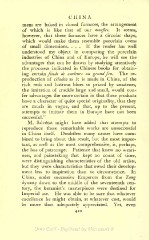Page 500 - Oriental Series Japan and China, Brinkly
P. 500
CHINA
mens are baked in closed furnaces, the arrangement
of which is like that of our moufles. It seems,
however, that these furnaces have a circular shape,
which would make them resemble porcelain ovens
of small dimensions. ... If the reader has well
understood my object in comparing the porcelain
industries of China and of Europe, he will see the
advantages that can be drawn by studying attentively
the processes indicated in Chinese books for obtain-
ing certain fonds de couleurs au grandfeu. The re-
production of celadon as it is made in China, of the
rich reds and lustrous blues so prized by amateurs,
the imitation of crackle large and small, would con-
fer advantages the more certain in that these products
have a character of quite special originality, that they
are much in vogue, and that, up to the present,
attempts to imitate them in Europe have not been
successful."
M. Salvetat might have added that attempts to
reproduce these remarkable works are unsuccessful
in China itself. Doubtless many causes have com-
bined to bring about this result, but the most impor-
tant, as well as the most comprehensive, is, perhaps,
the loss of patronage. Patience that knew no weari-
ness, and painstaking that kept no count of time,
were distinguishing characteristics of the old artists,
but they were characteristics that owed their develop-
ment less to inspiration than to circumstance. In
China, under successive Emperors from the Tang
dynasty down to the middle of the seventeenth cen-
tury, the keramist's masterpieces were destined for
Imperial use. He was able to be sure that whatever
excellence he might obtain, at whatever cost, would
be more than adequately appreciated. Yet, even
410

